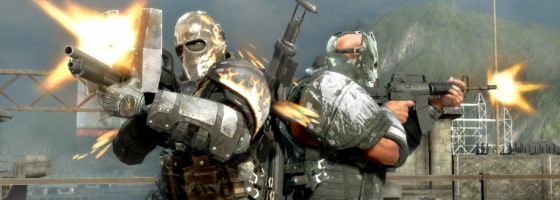Sometimes I can be thick when it comes to spotting an annoying pattern of game design, but this time I have the excuse of not having the money to buy too many AAA games.
Thanks to sales and such, I’ve been going through the backlog of AAA titles released and I noticed a pattern of content: third or first person shooting with excessive violence thrown in. When someone like me who has been playing video games for over 25 years has to stop and take notice, you know there is a problem.
Realty TV Game Development:
Violence in video games has been an always debated topic as along with sex, it is a major selling point.
But it wasn’t until this generation that our options for buying AAA games have become routinely filled with over-the-top violence. Bioshock Infinite for instance allowed you to blow the heads off of enemies with handguns and rip them apart with your grapple device.
In Tomb Raider, you could have a drinking game for every time something horrible happened to Lara.
But it’s not just violence, but a focus on only a limited set of mechanics: specifically cover based shooting. Both Resident Evil and Dead Space moved away from their horror roots for more action gameplay. The gameplay itself wasn’t even all inventive, with the same base mechanics.
Recently we saw how this cookie cutter design could kill a game with the title Fuse, from Insomniac Games. What happened was after focus testing, they decided to remove the unique elements of the game and make it more about gritty cover shooting instead of the over the top weaponry and gameplay.
That leaves us with a simple question: What Is Going on? The problem is that the same phenomenon that has happened with TV has taken root in the game industry — The majority voting for the same type of content.
Over the last decade we have seen a huge increase in the number of reality TV shows. Similar to the MMO explosion in the game industry, after the major developers saw the success of World of Warcraft, they wanted the same result.
With TV, after the success of shows like Survivor, Real Housewives and Jersey Shore, network execs want that same audience and change who they are catering to.
This is where the declaration of the “frat-boy influence” or “dude-bro” are coming from with the game industry. As developers saw the rise in sales from FPS series like Call of Duty and Halo or sports like Madden that attracted the college crowd.
What makes the college demographic so lucrative comes down to several factors. First is that they are old enough to play mature games, meaning that they are not limited by the age demographic of any title. Second is that they tend to have more disposable income compared to adults and children. Lastly is the tendency to play games with their friends which means more income with groups of people buying the same game.
As with the MMO surge of the early 00s, we are seeing developers either by choice or forced by publishers to aim for the most lucrative demographic, or as I talked about in an earlier post: selling out.
The simple solution would be to simply not cater to this demographic, but we are seeing more and more developers put between a rock and a hard place.
The Worse of Two Worlds:
A few months ago I wrote a piece examining the decline in quality among AAA developers. The biggest problem that we’re seeing with AAA development is the escalating cost of development. Publishers are spending more and more money both on the developers as well as advertising and that equals big bucks and the need for huge profits.
In order to offset the risk of development, publishers only want to deal with games that could be potential hits and what demographic have we talked about has been a key in massive sales?
This is why we have games like Bioshock Infinite with the same cover design as Call of Duty and Battlefield, or why Spec Ops and Tomb Raider needed multiplayer modes. We’re seeing more cases where developers are forced to sell out, or risk their company going under.
Developers are put into the position of sacrificing artistic integrity to attract more fans so that they can keep making the game they want, a problem that the indie community does not have.

Annually released series have huge profits with loyal fanbases that will usually stick to the one series and not much else.
With designers all trying to aim for the same demographic and design, it’s hurting the value of their games.
When everyone is promoting the same type of game, why should consumers buy something that they have already played?
When you have annual series like Call of Duty or Madden that are practically guaranteed hits, why should someone buy another companies’ FPS or sports title?
This can lead to a situation that no developer wants to be in: Their game is too similar to ones on the market to attract new fans, but too different to retain its loyal fan-base; a situation that Dead Space 3, Resident Evil 6 and Fuse suffered with.
When your only choice is to either outright pander to the popular majority or risk not being able to make any new games, what would you choose? In cases like with Bioshock Infinite and Spec Ops: The Line, they went with the former.
This has gotten to the point that even browser based free-to-play games like Wartune are constantly promoting their titles with the phrase “for men only” even if the game itself has nothing to do with mature content.
Pulling Out of the Dive:
With the cost of game development in the AAA market continuing to rise; it is becoming harder for major developers to recoup the cost of making games.
As more developers continue to pander to the same consumer base, we’re seeing a pattern indicative of the first game industry crash of the 80s: A lack of high quality titles and high costs led to consumer confidence disappearing and an expensive market with not enough people buying products to sustain.
Now the chance of a complete game industry crash happening again is zilch to none, thanks to the Indie market sustaining and adapting to the changes of the digital age. But AAA developers and publishers may not be so lucky.
The issue is trying to figure out what the best reasonable solution is. To clarify, this is not me making a call for everyone to stop making violent games but a call for more diversity. There’s an adage about how you can’t eat nothing but dessert, as eventually you crave something else.

Resident Evil 6 was regarded as one of the worse Resident Evil games released and an abandonment of the series’ roots.
There are more ways to create a mature game than having cover based shooting and online multiplayer.
Where are the games like Shadow of the Colossus, the original Dead Space or hell, even more gameplay refined titles like Mario or Portal.
I can tell you where they went — they were popular among niche groups, but nowhere near the same profits as Call of Duty or Gears of War. You can now find games like that in the Indie Market where they have thrived and became massive hits.
The biggest shift that AAA developers will need to do is to stop trying to compete with the current 800 pound gorilla, both in terms of design and marketing.
Not every game can or should be aimed at millions of sales, a lesson that companies like Atlus and Indie developers know full well. They know to budget their games accordingly and not to spend millions on advertising. They’re not developing their games to need 3 million sales to stay afloat and even getting into the hundred thousand can be a major victory for them.
Third and first person shooters have become the dominate genre in the AAA market and no market can survive off of one product. There is competition coming from smaller developers and Indies who can stay in business with quality titles and mobile and social developers providing cheap games for casual gamers.
Many MMOs following the surge of the market in the last decade faded away with companies closing in the process. This left us with only a handful of MMOs outside of World of Warcraft that survived the decline. And if the AAA industry isn’t careful, there may be a repeat of this situation.
Since the rise of digital distribution, the market has changed dramatically with major companies scrambling to adapt and with the fall of THQ still in recent memory, it’s anyone’s guess as to how the industry will look by the end of the decade.



